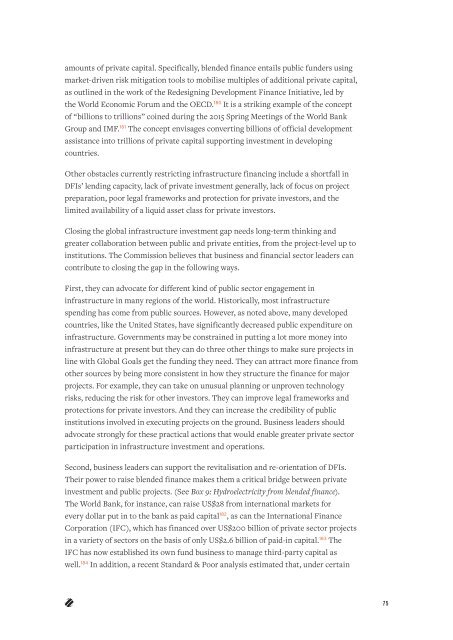BETTER BUSINESS BETTER WORLD
2jxE7K2
2jxE7K2
Create successful ePaper yourself
Turn your PDF publications into a flip-book with our unique Google optimized e-Paper software.
amounts of private capital. Specifically, blended finance entails public funders using<br />
market-driven risk mitigation tools to mobilise multiples of additional private capital,<br />
as outlined in the work of the Redesigning Development Finance Initiative, led by<br />
the World Economic Forum and the OECD. 180 It is a striking example of the concept<br />
of “billions to trillions” coined during the 2015 Spring Meetings of the World Bank<br />
Group and IMF. 181 The concept envisages converting billions of official development<br />
assistance into trillions of private capital supporting investment in developing<br />
countries.<br />
Other obstacles currently restricting infrastructure financing include a shortfall in<br />
DFIs’ lending capacity, lack of private investment generally, lack of focus on project<br />
preparation, poor legal frameworks and protection for private investors, and the<br />
limited availability of a liquid asset class for private investors.<br />
Closing the global infrastructure investment gap needs long-term thinking and<br />
greater collaboration between public and private entities, from the project-level up to<br />
institutions. The Commission believes that business and financial sector leaders can<br />
contribute to closing the gap in the following ways.<br />
First, they can advocate for different kind of public sector engagement in<br />
infrastructure in many regions of the world. Historically, most infrastructure<br />
spending has come from public sources. However, as noted above, many developed<br />
countries, like the United States, have significantly decreased public expenditure on<br />
infrastructure. Governments may be constrained in putting a lot more money into<br />
infrastructure at present but they can do three other things to make sure projects in<br />
line with Global Goals get the funding they need. They can attract more finance from<br />
other sources by being more consistent in how they structure the finance for major<br />
projects. For example, they can take on unusual planning or unproven technology<br />
risks, reducing the risk for other investors. They can improve legal frameworks and<br />
protections for private investors. And they can increase the credibility of public<br />
institutions involved in executing projects on the ground. Business leaders should<br />
advocate strongly for these practical actions that would enable greater private sector<br />
participation in infrastructure investment and operations.<br />
Second, business leaders can support the revitalisation and re-orientation of DFIs.<br />
Their power to raise blended finance makes them a critical bridge between private<br />
investment and public projects. (See Box 9: Hydroelectricity from blended finance).<br />
The World Bank, for instance, can raise US$28 from international markets for<br />
every dollar put in to the bank as paid capital 182 , as can the International Finance<br />
Corporation (IFC), which has financed over US$200 billion of private sector projects<br />
in a variety of sectors on the basis of only US$2.6 billion of paid-in capital. 183 The<br />
IFC has now established its own fund business to manage third-party capital as<br />
well. 184 In addition, a recent Standard & Poor analysis estimated that, under certain<br />
75


